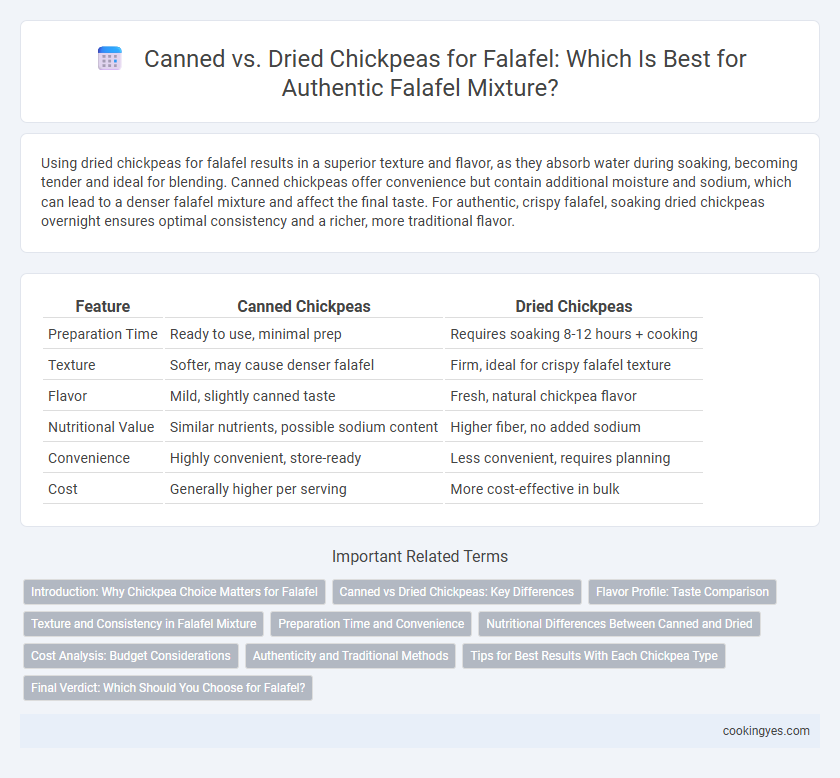Using dried chickpeas for falafel results in a superior texture and flavor, as they absorb water during soaking, becoming tender and ideal for blending. Canned chickpeas offer convenience but contain additional moisture and sodium, which can lead to a denser falafel mixture and affect the final taste. For authentic, crispy falafel, soaking dried chickpeas overnight ensures optimal consistency and a richer, more traditional flavor.
Table of Comparison
| Feature | Canned Chickpeas | Dried Chickpeas |
|---|---|---|
| Preparation Time | Ready to use, minimal prep | Requires soaking 8-12 hours + cooking |
| Texture | Softer, may cause denser falafel | Firm, ideal for crispy falafel texture |
| Flavor | Mild, slightly canned taste | Fresh, natural chickpea flavor |
| Nutritional Value | Similar nutrients, possible sodium content | Higher fiber, no added sodium |
| Convenience | Highly convenient, store-ready | Less convenient, requires planning |
| Cost | Generally higher per serving | More cost-effective in bulk |
Introduction: Why Chickpea Choice Matters for Falafel
Chickpeas are the foundational ingredient in falafel, directly influencing texture and flavor. Canned chickpeas offer convenience and moisture, leading to a softer falafel, while dried chickpeas must be soaked and yield a firmer, more authentic texture. Selecting the right type impacts the falafel's structural integrity and overall taste profile, making chickpea choice crucial for optimal results.
Canned vs Dried Chickpeas: Key Differences
Canned chickpeas offer convenience with their pre-cooked, soft texture, making them easier to mash but often resulting in a denser falafel mixture. Dried chickpeas require soaking and longer preparation time, yielding a firmer texture that creates lighter, crispier falafel when ground raw. The choice between canned and dried chickpeas significantly impacts moisture content, taste, and the overall consistency of the falafel mixture.
Flavor Profile: Taste Comparison
Canned chickpeas offer a milder, softer texture with a slightly salty flavor ideal for quick falafel preparation, while dried chickpeas provide a denser texture and nuttier, earthier taste that enhances the depth of traditional falafel. Soaking and cooking dried chickpeas allow better flavor absorption and a more authentic, robust profile compared to the often blander canned variety. Choosing dried chickpeas results in a superior falafel with richer taste complexity and improved structural integrity in the mixture.
Texture and Consistency in Falafel Mixture
Canned chickpeas offer convenience but tend to produce a softer falafel mixture, which can result in a less crispy exterior and a denser interior. Dried chickpeas, when soaked overnight, yield a firmer texture that enhances the crispiness and structural integrity of falafel. Using dried chickpeas ensures a better balance of moisture, contributing to a consistent mixture ideal for traditional falafel.
Preparation Time and Convenience
Canned chickpeas offer the advantage of significantly reducing preparation time for falafel since they are pre-cooked and ready to use, eliminating the need for lengthy soaking and boiling. Dried chickpeas require an overnight soak and extended cooking, which can be less convenient but allow for better control over texture and flavor. For quick and easy falafel preparation, canned chickpeas provide the most time-efficient option without compromising the essential taste and consistency.
Nutritional Differences Between Canned and Dried
Canned chickpeas contain higher sodium levels due to added salt in the preservation process, affecting overall sodium intake when making falafel. Dried chickpeas offer greater control over sodium content and retain more fiber, contributing to better digestive health and satiety in the falafel mixture. Both forms provide essential plant-based protein and important minerals like iron and magnesium, but dried chickpeas preserve nutrients more effectively without added preservatives.
Cost Analysis: Budget Considerations
Canned chickpeas for falafel offer convenience with a higher upfront cost, averaging around $1.50 to $2.00 per can, while dried chickpeas are significantly cheaper, costing approximately $1.50 to $2.00 per pound and expanding to yield more servings. Using dried chickpeas requires soaking and longer preparation time but reduces overall expenses, especially beneficial for bulk cooking and commercial falafel production. Budget-conscious cooks prioritize dried chickpeas to maximize cost-efficiency without compromising the authentic texture and flavor of the falafel mixture.
Authenticity and Traditional Methods
Dried chickpeas are preferred for authentic falafel because traditional recipes rely on soaking raw beans to achieve the proper texture and flavor, which canned chickpeas cannot replicate due to their pre-cooked nature. Soaking dried chickpeas overnight enhances their firmness and moisture absorption, essential for forming the dense, grainy falafel characteristic of Middle Eastern cuisine. Using dried chickpeas aligns with time-honored methods, preserving the genuine taste and structural integrity that define classic falafel.
Tips for Best Results With Each Chickpea Type
Using dried chickpeas for falafel requires soaking overnight for optimal texture and binding, producing a firmer, more authentic mixture. Canned chickpeas offer convenience but should be thoroughly drained and rinsed to reduce moisture and improve flavor concentration. Adjust seasoning and texture by adding breadcrumbs or flour when using canned chickpeas to achieve the ideal consistency for frying.
Final Verdict: Which Should You Choose for Falafel?
Dried chickpeas offer superior texture and flavor for falafel, as they absorb water during soaking, resulting in a firmer mixture that crisps well when fried. Canned chickpeas are convenient but tend to produce a mushier falafel due to their higher moisture content and softer consistency. For authentic, crispy falafel, dried chickpeas are the preferred choice despite the longer preparation time.
Canned vs Dried Chickpeas for Falafel Mixture Infographic

 cookingyes.com
cookingyes.com